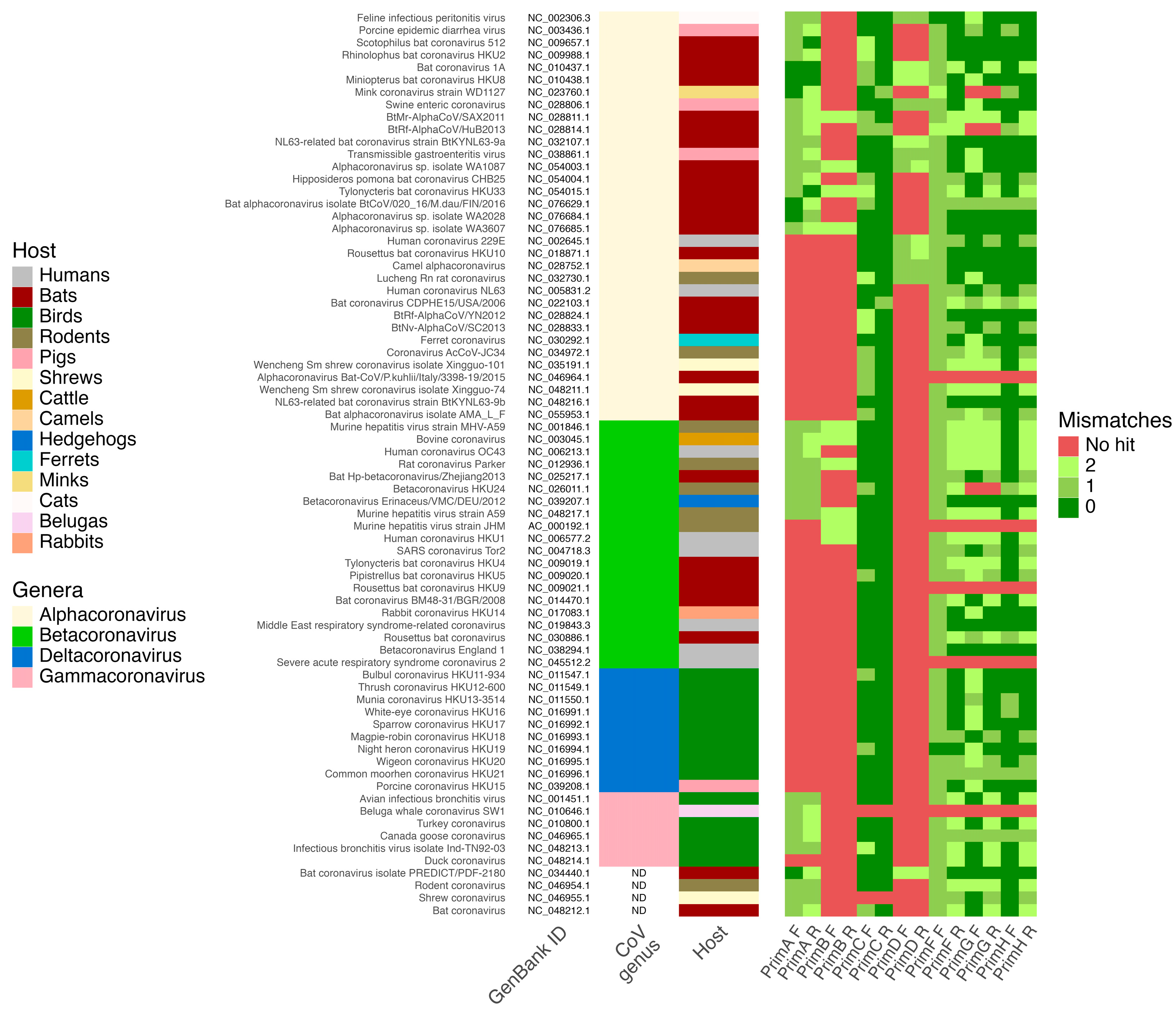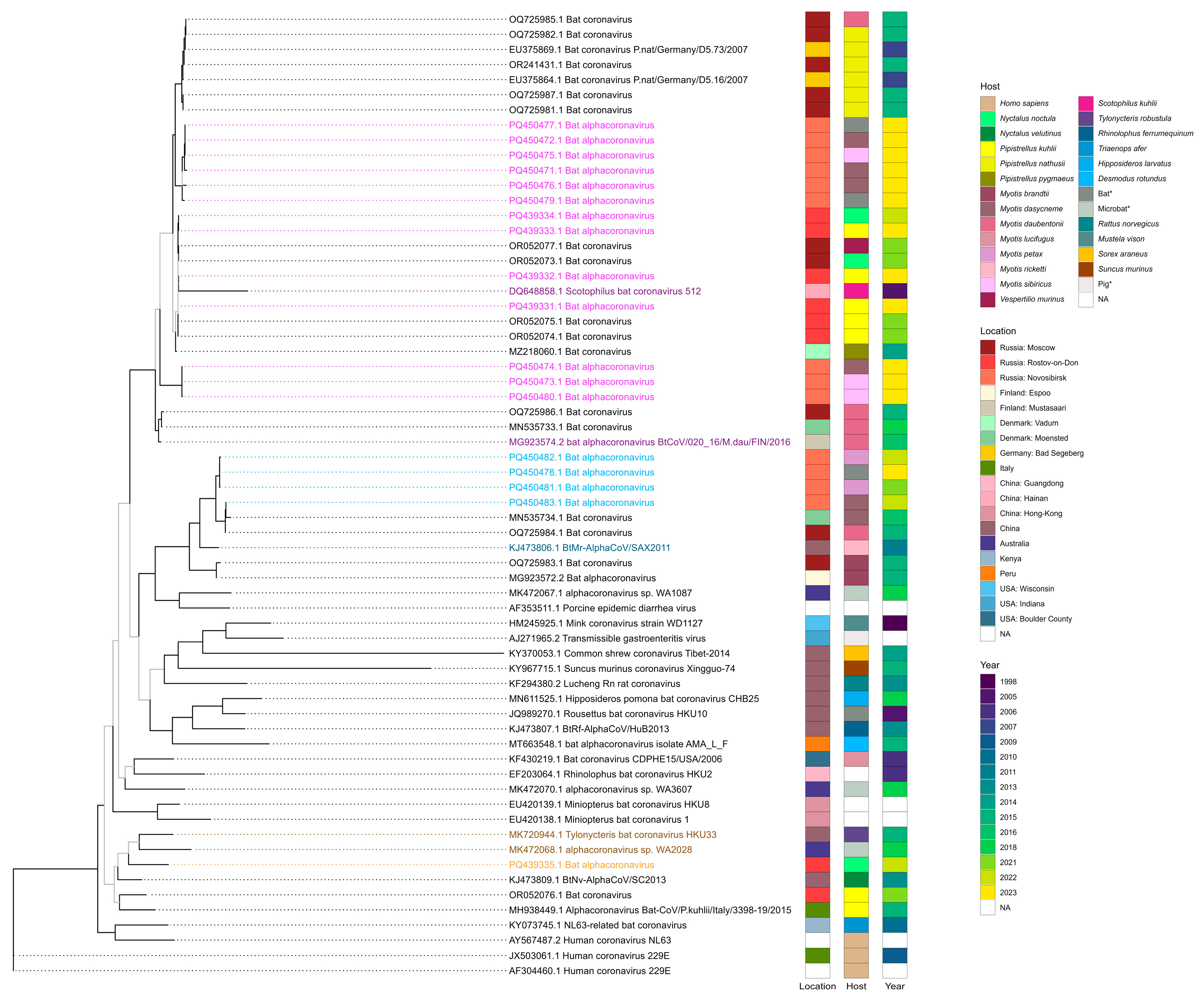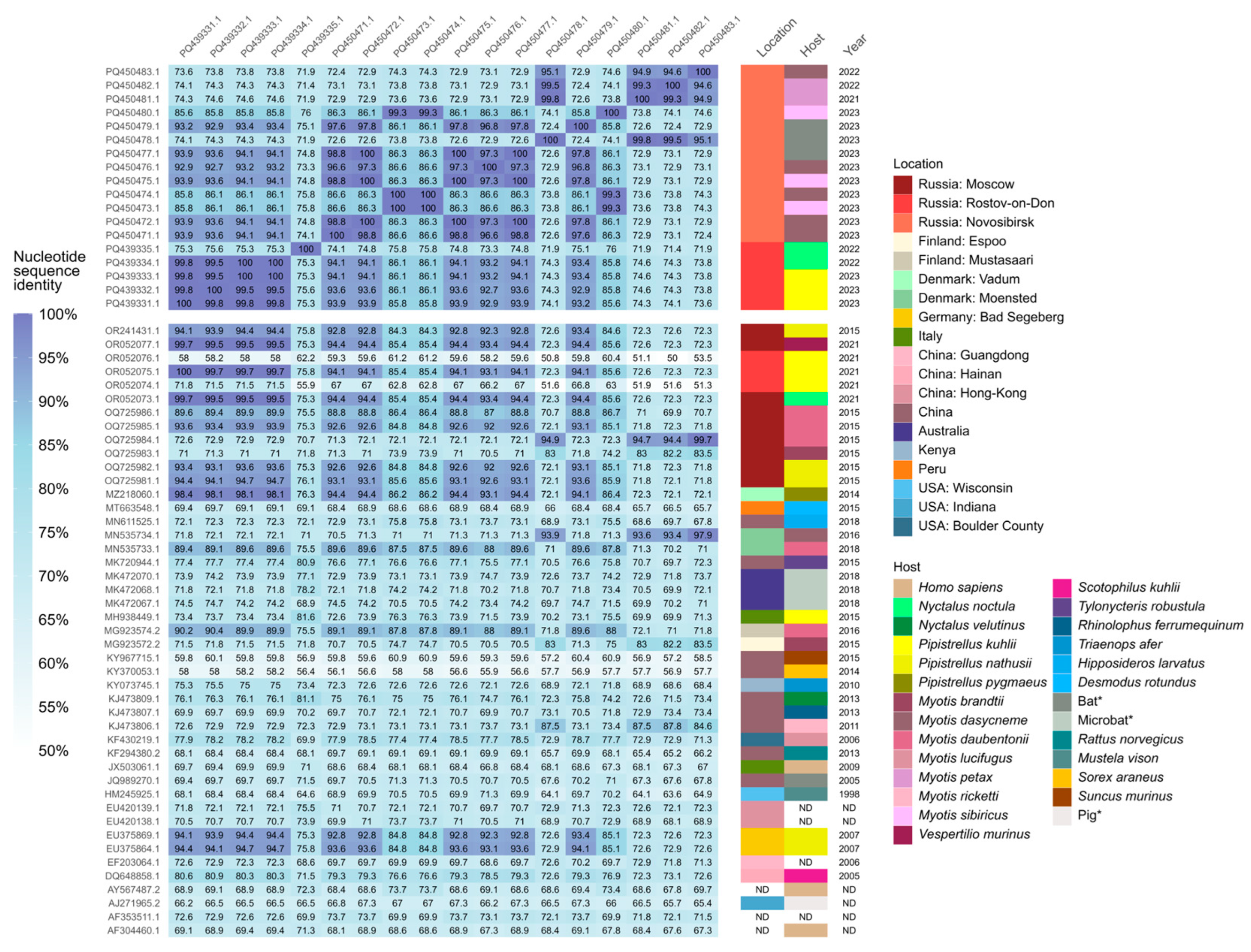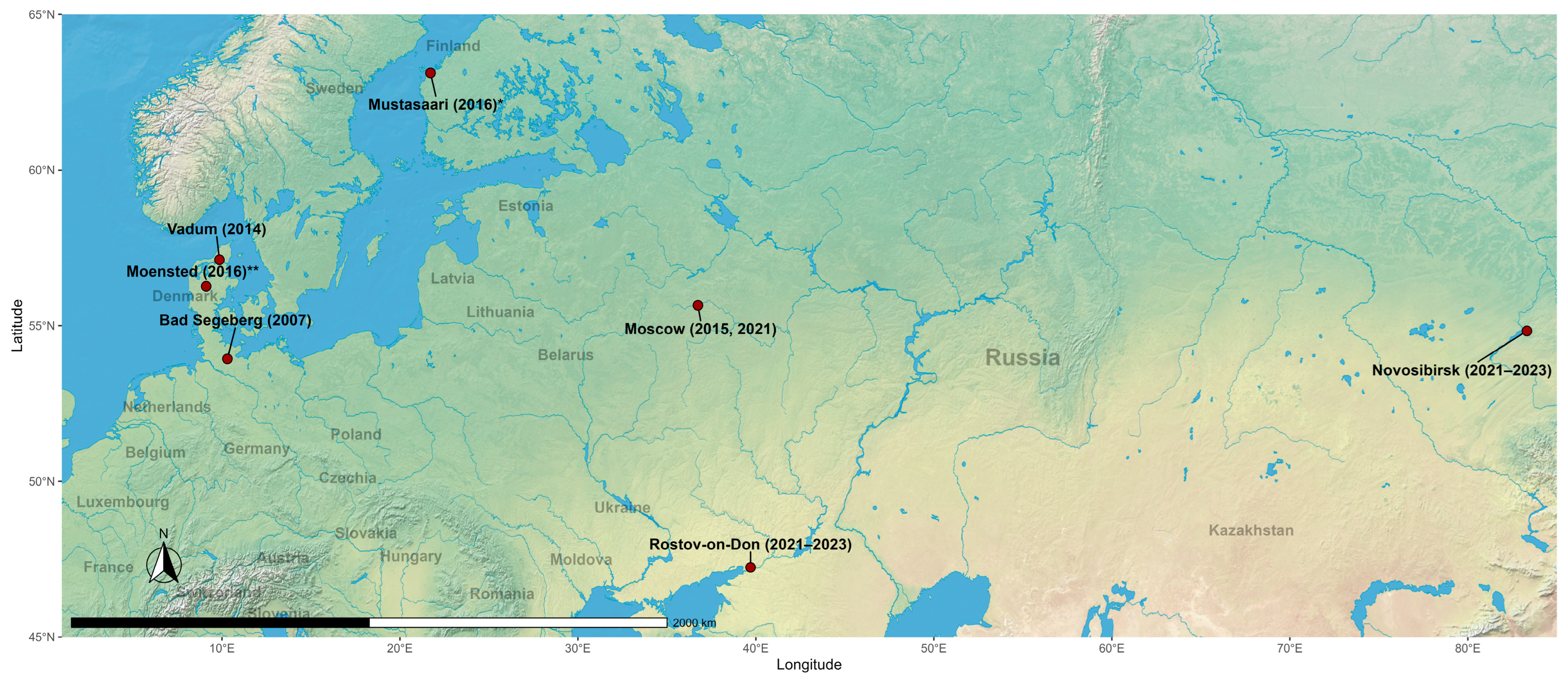Detection and Phylogenetic Analysis of Alphacoronaviruses in Bat Populations of Rostov and Novosibirsk Regions of Russia, 2021–2023
Abstract
1. Introduction
2. Materials and Methods
2.1. Sampling
2.1.1. Rostov Region
2.1.2. Novosibirsk Region
2.2. RNA Extraction
2.3. Primers Design and In Silico Analysis of Their Sensitivity and Specificity
2.4. PCR Screening and Sequencing
2.5. Bioinformatic Data Analysis
3. Results
3.1. In Silico PCR Analysis of Designed Primers Sensitivity and Specificity
3.2. PCR Screening and Sequencing
3.3. Phylogenetic and Nucleotide Sequence Identity Analysis of Detected Coronaviruses
4. Discussion
5. Conclusions
Author Contributions
Funding
Institutional Review Board Statement
Data Availability Statement
Acknowledgments
Conflicts of Interest
References
- Ji, W.; Wang, W.; Zhao, X.; Zai, J.; Li, X. Cross-species transmission of the newly identified coronavirus 2019-nCoV. J. Med. Virol. 2020, 92, 433–440. [Google Scholar] [CrossRef] [PubMed]
- Workman, A.M.; McDaneld, T.G.; Harhay, G.P.; Das, S.; Loy, J.D.; Hause, B.M. Recent emergence of bovine coronavirus variants with mutations in the hemagglutinin-esterase receptor binding domain in US cattle. Viruses 2022, 14, 2125. [Google Scholar] [CrossRef]
- Dhama, K.; Patel, S.K.; Sharun, K.; Pathak, M.; Tiwari, R.; Yatoo, M.I.; Malik, Y.S.; Sah, R.; Rabaan, A.A.; Panwar, P.K.; et al. SARS-CoV-2 jumping the species barrier: Zoonotic lessons from SARS, MERS and recent advances to combat this pandemic virus. Travel Med. Infect. Dis. 2020, 37, 101830. [Google Scholar] [CrossRef] [PubMed]
- Donnik, I.; Popov, I.V.; Sereda, S.; Popov, I.V.; Chikindas, M.; Ermakov, A. Coronavirus infections of animals: Future risks to humans. Biol. Bull. 2021, 48, 26–37. [Google Scholar] [CrossRef] [PubMed]
- Guan, Y.J.; Zheng, B.J.; He, Y.Q.; Liu, X.L.; Zhuang, Z.X.; Cheung, C.L.; Luo, S.W.; Li, P.H.; Zhang, L.J.; Butt, K.M.; et al. Isolation and characterization of viruses related to the SARS coronavirus from animals in southern China. Science 2003, 302, 276–278. [Google Scholar] [CrossRef]
- Crits-Christoph, A.; Levy, J.I.; Pekar, J.E.; Goldstein, S.A.; Singh, R.; Hensel, Z.; Gangavarapu, K.; Rogers, M.B.; Moshiri, N.; Garry, R.F.; et al. Genetic tracing of market wildlife and viruses at the epicenter of the COVID-19 pandemic. Cell 2024, 187, 5468–5482.e5411. [Google Scholar] [CrossRef] [PubMed]
- Banerjee, A.; Kulcsar, K.; Misra, V.; Frieman, M.; Mossman, K. Bats and coronaviruses. Viruses 2019, 11, 41. [Google Scholar] [CrossRef]
- Serra-Cobo, J.; Lopez-Roig, M. Bats and Emerging Infections: An Ecological and Virological Puzzle. In Emerging and Re-Emerging Viral Infections: Advances in Microbiology, Infectious Diseases and Public Health; Springer: Berlin/Heidelberg, Germany, 2014; Volume 6, pp. 35–48. [Google Scholar]
- Banerjee, A.; Baker, M.L.; Kulcsar, K.; Misra, V.; Plowright, R.; Mossman, K. Novel insights into immune systems of bats. Front. Immunol. 2020, 11, 26. [Google Scholar] [CrossRef]
- Hu, B.; Ge, X.; Wang, L.F.; Shi, Z. Bat origin of human coronaviruses. Virol. J. 2015, 12, 221. [Google Scholar] [CrossRef]
- Zhou, H.; Ji, J.; Chen, X.; Bi, Y.; Li, J.; Wang, Q.; Hu, T.; Song, H.; Zhao, R.; Chen, Y. Identification of novel bat coronaviruses sheds light on the evolutionary origins of SARS-CoV-2 and related viruses. Cell 2021, 184, 4380–4391.e4314. [Google Scholar] [CrossRef] [PubMed]
- Tiwari, S.K.; Dicks, L.M.; Popov, I.V.; Karaseva, A.; Ermakov, A.M.; Suvorov, A.; Tagg, J.R.; Weeks, R.; Chikindas, M.L. Probiotics at war against viruses: What is missing from the picture? Front. Microbiol. 2020, 11, 1877. [Google Scholar] [CrossRef] [PubMed]
- Brussel, K.V.; Holmes, E.C. Zoonotic disease and virome diversity in bats. Curr. Opin. Virol. 2022, 52, 192–202. [Google Scholar] [CrossRef] [PubMed]
- Smith, C.S.; Jong, C.E.D.; Field, H.E. Sampling small quantities of blood from microbats. Acta Chiropterologica 2010, 12, 255–258. [Google Scholar] [CrossRef]
- Tamura, K.; Stecher, G.; Kumar, S. MEGA11: Molecular evolutionary genetics analysis, version 11. Mol. Biol. Evol. 2021, 38, 3022–3027. [Google Scholar] [CrossRef]
- Woo, P.; Huang, Y.; Lau, S.; Yuen, K. Coronavirus Genomics and Bioinformatics Analysis. Viruses 2010, 2, 1804–1820. [Google Scholar] [CrossRef] [PubMed]
- Koonin, E. The phylogeny of RNA-dependent RNA polymerases of positive-strand RNA viruses. J. Gen. Virol. 1991, 72 Pt 9, 2197–2206. [Google Scholar] [CrossRef] [PubMed]
- Hillen, H.; Kokic, G.; Farnung, L.; Dienemann, C.; Tegunov, D.; Cramer, P. Structure of replicating SARS-CoV-2 polymerase. Nature 2020, 584, 154–156. [Google Scholar] [CrossRef]
- Kibbe, W.A. OligoCalc: An online oligonucleotide properties calculator. Nucleic Acids Res. 2007, 35, W43–W46. [Google Scholar] [CrossRef] [PubMed]
- Vijgen, L.; Moës, E.; Keyaerts, E.; Li, S.; Ranst, M.V. A pancoronavirus RT-PCR assay for detection of all known coronaviruses. In SARS-and Other Coronaviruses: Laboratory Protocols; Humana Press: Totowa, NJ, USA, 2008; pp. 3–12. [Google Scholar]
- Watanabe, S.; Masangkay, J.S.; Nagata, N.; Morikawa, S.; Mizutani, T.; Fukushi, S.; Alviola, P.; Omatsu, T.; Ueda, N.; Iha, K.; et al. Bat coronaviruses and experimental infection of bats, the Philippines. Emerg. Infect. Dis. 2010, 16, 1217. [Google Scholar] [CrossRef]
- Holbrook, M.G.; Anthony, S.J.; Navarrete-Macias, I.; Bestebroer, T.; Munster, V.J.; van Doremalen, N. Updated and validated pan-coronavirus PCR assay to detect all coronavirus genera. Viruses 2021, 13, 599. [Google Scholar] [CrossRef] [PubMed]
- Pruitt, K.D.; Tatusova, T.; Maglott, D.R. NCBI reference sequences (RefSeq): A curated non-redundant sequence database of genomes, transcripts and proteins. Nucleic Acids Res. 2007, 35, D61–D65. [Google Scholar] [CrossRef] [PubMed]
- Wickham, H.; Wickham, H. Data Analysis; Springer: Berlin/Heidelberg, Germany, 2016. [Google Scholar]
- Camacho, C.; Coulouris, G.; Avagyan, V.; Ma, N.; Papadopoulos, J.; Bealer, K.; Madden, T.L. BLAST+: Architecture and applications. BMC Bioinform. 2009, 10, 421. [Google Scholar] [CrossRef] [PubMed]
- Kim, J.; Steinegger, M. Metabuli: Sensitive and specific metagenomic classification via joint analysis of amino acid and DNA. Nat. Methods 2024, 21, 971–973. [Google Scholar] [CrossRef] [PubMed]
- Korneenko, E.V.; Samoilov, A.E.; Chudinov, I.K.; Butenko, I.O.; Sonets, I.V.; Artyushin, I.V.; Yusefovich, A.P.; Kruskop, S.V.; Sinitsyn, S.O.; Klyuchnikova, E.O.; et al. Alphacoronaviruses from bats captured in European Russia in 2015 and 2021 are closely related to those of Northern Europe. Front. Ecol. Evol. 2024, 12, 1324605. [Google Scholar] [CrossRef]
- Clark, K.; Karsch-Mizrachi, I.; Lipman, D.J.; Ostell, J.; Sayers, E.W. GenBank. Nucleic Acids Res. 2016, 44, D67–D72. [Google Scholar] [CrossRef] [PubMed]
- Kans, J. Entrez direct: E-Utilities on the UNIX Command Line. In Entrez Programming Utilities Help; National Center for Biotechnology Information: Bethesda, MD, USA, 2024. [Google Scholar]
- Katoh, K.; Standley, D.M. MAFFT multiple sequence alignment software version 7: Improvements in performance and usability. Mol. Biol. Evol. 2013, 30, 772–780. [Google Scholar] [CrossRef]
- Capella-Gutiérrez, S.; Silla-Martínez, J.M.; Gabaldón, T. trimAl: A tool for automated alignment trimming in large-scale phylogenetic analyses. Bioinformatics 2009, 25, 1972–1973. [Google Scholar] [CrossRef]
- Kalyaanamoorthy, S.; Minh, B.Q.; Wong, T.K.; Von Haeseler, A.; Jermiin, L.S. ModelFinder: Fast model selection for accurate phylogenetic estimates. Nat. Methods 2017, 14, 587–589. [Google Scholar] [CrossRef] [PubMed]
- Nguyen, L.-T.; Schmidt, H.A.; Von Haeseler, A.; Minh, B.Q. IQ-TREE: A fast and effective stochastic algorithm for estimating maximum-likelihood phylogenies. Mol. Biol. Evol. 2015, 32, 268–274. [Google Scholar] [CrossRef] [PubMed]
- Hoang, D.T.; Chernomor, O.; Von Haeseler, A.; Minh, B.Q.; Vinh, L.S. UFBoot2: Improving the ultrafast bootstrap approximation. Mol. Biol. Evol. 2018, 35, 518–522. [Google Scholar] [CrossRef] [PubMed]
- Yu, G.; Smith, D.K.; Zhu, H.; Guan, Y.; Lam, T.T.Y. ggtree: An R package for visualization and annotation of phylogenetic trees with their covariates and other associated data. Methods Ecol. Evol. 2017, 8, 28–36. [Google Scholar] [CrossRef]
- South, A.; South, M.A. R Package: Rnaturalearth. World Map Data from Natural Earth, Version 0.1.0. Available online: https://cran.r-project.org/web/packages/rnaturalearth/rnaturalearth.pdf (accessed on 12 November 2024).
- Tang, X.; Zhang, J.; Zhang, S.; Wang, P.; Fan, X.; Li, L.; Li, G.; Dong, B.; Liu, W.; Cheung, C.; et al. Prevalence and genetic diversity of coronaviruses in bats from China. J. Virol. 2006, 80, 7481–7490. [Google Scholar] [CrossRef] [PubMed]
- Wu, Z.; Yang, L.; Ren, X.; He, G.; Zhang, J.; Yang, J.; Qian, Z.; Dong, J.; Sun, L.; Zhu, Y.; et al. Deciphering the bat virome catalog to better understand the ecological diversity of bat viruses and the bat origin of emerging infectious diseases. ISME J. 2016, 10, 609–620. [Google Scholar] [CrossRef]
- Lau, S.K.; Wong, A.C.; Zhang, L.; Luk, H.K.; Kwok, J.S.; Ahmed, S.S.; Cai, J.-P.; Zhao, P.S.; Teng, J.L.; Tsui, S.K.; et al. Novel bat alphacoronaviruses in southern China support Chinese horseshoe bats as an important reservoir for potential novel coronaviruses. Viruses 2019, 11, 423. [Google Scholar] [CrossRef]
- Lazov, C.M.; Belsham, G.J.; Bøtner, A.; Rasmussen, T.B. Full-genome sequences of alphacoronaviruses and astroviruses from myotis and pipistrelle bats in Denmark. Viruses 2021, 13, 1073. [Google Scholar] [CrossRef] [PubMed]
- Gloza-Rausch, F.; Ipsen, A.; Seebens, A.; Göttsche, M.; Panning, M.; Drexler, J.F.; Petersen, N.; Annan, A.; Grywna, K.; Müller, M.; et al. Detection and prevalence patterns of group I coronaviruses in bats, northern Germany. Emerg. Infect. Dis. 2008, 14, 626. [Google Scholar] [CrossRef] [PubMed]
- Popov, I.V.; Ohlopkova, O.V.; Donnik, I.M.; Zolotukhin, P.V.; Umanets, A.; Golovin, S.N.; Malinovkin, A.V.; Belanova, A.A.; Lipilkin, P.V.; Lipilkina, T.A.; et al. Detection of coronaviruses in insectivorous bats of Fore-Caucasus, 2021. Sci. Rep. 2023, 13, 2306. [Google Scholar] [CrossRef]
- Yashina, L.N.; Zhigalin, A.V.; Abramov, S.A.; Luchnikova, E.M.; Smetannikova, N.A.; Dupal, T.A.; Krivopalov, A.V.; Vdovina, E.D.; Svirin, K.A.; Gadzhiev, A.A.; et al. Coronaviruses (Coronaviridae) of bats in the northern Caucasus and south of western Siberia. Probl. Virol. 2024, 69, 255–265. [Google Scholar] [CrossRef]
- Yashina, L.N.; Zhigalin, A.V.; Abramov, S.A.; Luchnikova, E.M.; Smetannikova, N.A.; Dupal, T.A.; Krivopalov, A.V.; Vdovina, E.D.; Svirin, K.A.; Gadzhiev, A.A.; et al. Identification and genetic characterization of MERS-related coronavirus isolated from Nathusius’ pipistrelle (Pipistrellus nathusii) near Zvenigorod (Moscow region, Russia). Int. J. Environ. Res. Public Health 2023, 20, 3702. [Google Scholar] [CrossRef] [PubMed]
- Radford, A.D.; Chapman, D.; Dixon, L.; Chantrey, J.; Darby, A.C.; Hall, N. Application of next-generation sequencing technologies in virology. J. Gen. Virol. 2012, 93, 1853–1868. [Google Scholar] [CrossRef] [PubMed]
- Lehnert, L.S.; Kramer-Schadt, S.; Teige, T.; Hoffmeister, U.; Popa-Lisseanu, A.; Bontadina, F.; Ciechanowski, M.; Dechmann, D.K.N.; Kravchenko, K.; Presetnik, P.; et al. Variability and repeatability of noctule bat migration in Central Europe: Evidence for partial and differential migration. Proc. R. Soc. B 2018, 285, 20182174. [Google Scholar] [CrossRef]
- Bray, T.C.; Mohammed, O.B.; Alagaili, A.N. Phylogenetic and demographic insights into Kuhl’s Pipistrelle, Pipistrellus kuhlii, in the Middle East. PLoS ONE 2013, 8, e57306. [Google Scholar] [CrossRef] [PubMed]
- Gunnell, G.F.; Smith, R.; Smith, T. 33 million year old Myotis (Chiroptera, Vespertilionidae) and the rapid global radiation of modern bats. PLoS ONE 2017, 12, e0172621. [Google Scholar] [CrossRef]
- Wang, L.-F.; Anderson, D.E. Viruses in bats and potential spillover to animals and humans. Curr. Opin. Virol. 2019, 34, 79–89. [Google Scholar] [CrossRef]
- Smith, I.; Wang, L.-F. Bats and their virome: An important source of emerging viruses capable of infecting humans. Curr. Opin. Virol. 2013, 3, 84–91. [Google Scholar] [CrossRef]
- Brook, C.E.; Rozins, C.; Guth, S.; Boots, M. Reservoir host immunology and life history shape virulence evolution in zoonotic viruses. PLoS Biol. 2023, 21, e3002268. [Google Scholar] [CrossRef] [PubMed]
- Bolatti, E.M.; Viarengo, G.; Zorec, T.M.; Cerri, A.; Montani, M.E.; Hosnjak, L.; Casal, P.E.; Bortolotto, E.; Di Domenica, V.; Chouhy, D.; et al. Viral metagenomic data analyses of five new world bat species from Argentina: Identification of 35 novel DNA viruses. Microorganisms 2022, 10, 266. [Google Scholar] [CrossRef] [PubMed]
- Ge, X.; Li, Y.; Yang, X.; Zhang, H.; Zhou, P.; Zhang, Y.; Shi, Z. Metagenomic analysis of viruses from bat fecal samples reveals many novel viruses in insectivorous bats in China. J. Virol. 2012, 86, 4620–4630. [Google Scholar] [CrossRef]
- Mishra, N.; Fagbo, S.F.; Alagaili, A.N.; Nitido, A.; Williams, S.H.; Ng, J.; Lee, B.; Durosinlorun, A.; Garcia, J.A.; Jain, K.; et al. A viral metagenomic survey identifies known and novel mammalian viruses in bats from Saudi Arabia. PLoS ONE 2019, 14, e0214227. [Google Scholar] [CrossRef] [PubMed]




| Bat Species | Number of Bats | Number of Samples | Origin of the Sample | |||
|---|---|---|---|---|---|---|
| Blood | Oropharyngeal Swab | Organ Autopsies | Feces 1 | |||
| 2022 year | ||||||
| Vespertilio murinus | 20 | 38 | - | - | - | 38 |
| Nyctalus noctula | 169 | 557 | 81 | 338 | 32 | 106 |
| Pipistrellus kuhlii | 1 | 19 | - | - | 56 | - |
| Eptesicus serotinus | 2 | 19 | - | - | 17 | 2 |
| 2023 year | ||||||
| Vespertilio murinus | 2 | 3 | - | - | - | 3 |
| Nyctalus noctula | 61 | 91 | - | - | 15 | 76 |
| Pipistrellus kuhlii | 11 | 28 | - | - | 13 | 15 |
| Eptesicus serotinus | 4 | 6 | - | - | - | 6 |
| Bat Species | Number of Bats | Number of Samples | Origin of the Sample | |||
|---|---|---|---|---|---|---|
| Blood | Oropharyngeal Swab | Organ Autopsies | Feces | |||
| 2021 year | ||||||
| Novosibirsk | ||||||
| Vespertilio murinus | 16 | 35 | 9 | - | 26 | - |
| Myotis dasycneme | 1 | 1 | 1 | - | - | - |
| Iskitimsky district | ||||||
| Myotis dasycneme | 5 | 15 | 5 | - | 10 | - |
| Myotis petax | 1 | 3 | 1 | - | 2 | - |
| Vespetio murinus | 3 | 9 | 3 | - | 6 | - |
| Maslyaninsky district | ||||||
| Myotis petax | 11 | 11 | 11 | - | - | - |
| Myotis dasycneme | 1 | 2 | 1 | - | 1 | - |
| Murina hilgendorfi | 7 | 7 | 7 | - | - | - |
| Vespetio murinus | 1 | 1 | - | - | 1 | - |
| 2022 year | ||||||
| Novosibirsk | ||||||
| Vespertilio murinus | 6 | 12 | - | - | 12 | - |
| Myotis dasycneme | 1 | 3 | 1 | - | 2 | - |
| Iskitimsky district | ||||||
| Myotis dasycneme | 2 | 6 | 2 | - | 4 | - |
| Myotis petax | 6 | 18 | 6 | - | 12 | - |
| Myotis sibiricus | 3 | 6 | 1 | - | 5 | - |
| Maslyaninsky district | ||||||
| Myotis petax | 2 | 2 | 2 | - | - | - |
| Murina hilgendorfi | 1 | 1 | 1 | - | - | - |
| 2023 year | ||||||
| Novosibirsk | ||||||
| Vespertilio murinus | 22 | 38 | 1 | 1 | 3 | 33 |
| Myotis dasycneme | 1 | 1 | - | 1 | - | - |
| Eptesicus nilssonii | 3 | 3 | - | - | - | 3 |
| Iskitimsky district | ||||||
| Myotis dasycneme | 24 | 45 | - | 23 | - | 22 |
| Myotis petax | 3 | 10 | 2 | 3 | 2 | 3 |
| Vespetio murinus | 4 | 7 | - | 4 | - | 3 |
| Myotis sibiricus | 8 | 15 | - | 7 | - | 8 |
| Eptesicus nilssonii | 3 | 6 | - | 3 | - | 3 |
| Nyctalus noctula | 1 | 2 | - | 1 | - | 1 |
| Maslyaninsky district | ||||||
| Myotis petax | 11 | 11 | - | 11 | - | - |
| Murina hilgendorfi | 6 | 6 | - | 6 | - | - |
| ND 1 | ND 1 | 15 | - | - | - | 15 1 |
| Bat Species | Positive Signals/Number of Bats | Positive Signals/Number of Samples | Positive Signals/Number of Samples and Their Origin | |||
|---|---|---|---|---|---|---|
| Blood | Oropharyngeal Swab | Organ Autopsies | Feces 1 | |||
| Rostov region | ||||||
| 2021 year | ||||||
| Vespertilio murinus | ND 1/20 | 2/38 | - | - | - | 2/38 |
| Nyctalus noctula | ND 1/169 | 9/557 | 0/81 | 1/338 | 0/32 | 8/106 |
| 2022 year | ||||||
| Nyctalus noctula | ND 1/61 | 8/91 | - | - | 0/15 | 8/76 |
| Pipistrellus kuhlii | ND 1/11 | 4/28 | - | - | 0/13 | 4/15 |
| Novosibirsk region | ||||||
| 2021 year | ||||||
| Maslyaninsky district | ||||||
| Myotis petax | 1/11 | 1/11 | 1/11 | - | - | - |
| 2022 year | ||||||
| Novosibirsk | ||||||
| Myotis dasycneme | 1/1 | 1/3 | 1/1 | - | 2 | - |
| Iskitimsky district | ||||||
| Myotis petax | 1/6 | 1/18 | 1/6 | - | 12 | - |
| Maslyaninsky district | ||||||
| 2023 year | ||||||
| Novosibirsk | ||||||
| Iskitimsky district | ||||||
| Myotis dasycneme | 6/24 | 6/45 | - | 0/23 | - | 6/22 |
| Vespetio murinus | 1/4 | 1/7 | - | 0/4 | - | 1/3 |
| Myotis sibiricus | 6/8 | 6/15 | - | 1/7 | - | 5/8 |
| Maslyaninsky district | ||||||
| ND 2 | ND 2 | 3/15 | - | - | - | 3/15 2 |
Disclaimer/Publisher’s Note: The statements, opinions and data contained in all publications are solely those of the individual author(s) and contributor(s) and not of MDPI and/or the editor(s). MDPI and/or the editor(s) disclaim responsibility for any injury to people or property resulting from any ideas, methods, instructions or products referred to in the content. |
© 2024 by the authors. Licensee MDPI, Basel, Switzerland. This article is an open access article distributed under the terms and conditions of the Creative Commons Attribution (CC BY) license (https://creativecommons.org/licenses/by/4.0/).
Share and Cite
Ohlopkova, O.V.; Popov, I.V.; Popov, I.V.; Stolbunova, K.A.; Stepanyuk, M.A.; Moshkin, A.D.; Maslov, A.A.; Sobolev, I.A.; Malinovkin, A.V.; Tkacheva, E.V.; et al. Detection and Phylogenetic Analysis of Alphacoronaviruses in Bat Populations of Rostov and Novosibirsk Regions of Russia, 2021–2023. Microbiol. Res. 2025, 16, 3. https://doi.org/10.3390/microbiolres16010003
Ohlopkova OV, Popov IV, Popov IV, Stolbunova KA, Stepanyuk MA, Moshkin AD, Maslov AA, Sobolev IA, Malinovkin AV, Tkacheva EV, et al. Detection and Phylogenetic Analysis of Alphacoronaviruses in Bat Populations of Rostov and Novosibirsk Regions of Russia, 2021–2023. Microbiology Research. 2025; 16(1):3. https://doi.org/10.3390/microbiolres16010003
Chicago/Turabian StyleOhlopkova, Olesia V., Igor V. Popov, Ilia V. Popov, Kristina A. Stolbunova, Marina A. Stepanyuk, Alexey D. Moshkin, Aleksei A. Maslov, Ivan A. Sobolev, Aleksey V. Malinovkin, Elizaveta V. Tkacheva, and et al. 2025. "Detection and Phylogenetic Analysis of Alphacoronaviruses in Bat Populations of Rostov and Novosibirsk Regions of Russia, 2021–2023" Microbiology Research 16, no. 1: 3. https://doi.org/10.3390/microbiolres16010003
APA StyleOhlopkova, O. V., Popov, I. V., Popov, I. V., Stolbunova, K. A., Stepanyuk, M. A., Moshkin, A. D., Maslov, A. A., Sobolev, I. A., Malinovkin, A. V., Tkacheva, E. V., Bogdanova, D. A., Lukbanova, E. A., Ermakov, A. M., Alekseev, A. Y., Todorov, S. D., & Shestopalov, A. M. (2025). Detection and Phylogenetic Analysis of Alphacoronaviruses in Bat Populations of Rostov and Novosibirsk Regions of Russia, 2021–2023. Microbiology Research, 16(1), 3. https://doi.org/10.3390/microbiolres16010003






